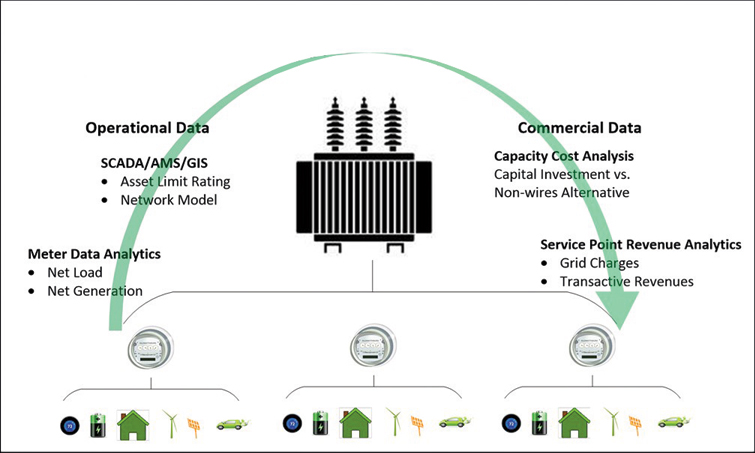Why Utilities Will Need More Granular Financial Analyses to Support 21st Century Business Models
The proliferation of DERs and the emerging “prosumer” are rapidly changing the way electricity is generated, distributed and consumed. This transformational shift in physical power delivery is beginning to turn the utility business model of the past century on its head. For investor-owned utilities (IOUs), the historical, and, for the most part, successful business model has revolved around a cycle of capital spending on system resources supported by a regulated rate of return through rate-based revenues. This model has been the de-facto standard of the distribution utility since the introduction of “Bonbright’s Rate Design Principles” a half-century ago.
Regulatory rate setting produced predictable revenue streams. This, in turn, provided utilities access to low-cost capital secured by bonds to fund the development of the largest interconnected machine in the world – the North American electric grid.
Locational Resource Planning with Granular Data
For the past 50 years, utility corporate planning has revolved around regulatory approved capital spending plans and the resulting rate-based revenue recovery over the life of capital assets. Investments in system expansion, upgrades and other capital-intensive proj¬ects were designed to service the system peak capacity requirements. Until recently, these requirements were determined through the extrapolation of sampling data per rate class and aggregated up to the asset level by a combination of service-point profiles, as well as some actual interval data from commercial accounts with interval-data recorders. This statistical exercise was based largely on estimations and assumptions but did not accurately aggregate load to reflect system constraints on assets hour-by-hour, for example.
System planners currently design system requirements to meet peak load requirements on upstream system assets (e.g., substations, feeders and associated lines). Using the extrapolated statistical approach previously mentioned, these peak load requirements are based upon the system load at certain hours of the year. Reliability is “job one” for utilities, so, in many cases, this approach has led engineers to err on the side of caution and oversize assets and/or prematurely upgrade them. Needless to say, this has led to inefficient capacity utilization.
As AMI replaces scalar meters across the distribution system, hourly (or even sub-hourly) data will become the standard measurement interval for all service point measurements. This granular spatial and temporal data will provide utility system planners with aggregate asset level data that more accurately reflects the flows on every system asset for every measurement period. Service point-by-service point, hour-by-hour, minute-by-minute and second-by-second analysis of this granular data will reveal where and when power flow is approaching or violating a system asset limit. The capability to forecast the net power consumption or generation at each service point will provide system planners with asset constraint forecasts for every hour of the year — from tomorrow to 20 years out.
With granular forecasted data, system engineers can conduct locational resource planning to more accurately evaluate upgrades and size equipment to improve capacity utilization. By better understanding granular power flows on assets, and identifying when and for how long generation or loading creates a constraint on an asset, utilities will be able to target investments or incentivize customers to shift load and defer costly system upgrades. These non-wires alternatives (NWA) have been implemented as pilot projects across the country. Many utility regulators are requiring utilities to consider this design approach in lieu of, or at least as an analytical alternative, for long-term rate base capital improvement.
Transactive Cost of Service Driven by the New Prosumer
The transformation underway in the electric utility industry is truly a consumer-driven sea change. It may not yet be affecting every utility in every state. However, as more homes are built or retrofitted with solar panels, energy storage, home energy management systems, and garages equipped for electric vehicles, the emergence of the prosumer will change the utility business model. To better understand the changing needs of the prosumer and effectively and equitably serve their needs, utilities will need to develop new cost-of-service models that reflect the true value of the grid as a platform.
The prosumer cost of service model will be a blend of transactional service charges and fixed charges associated with grid services. Grid services will include costs associated with reliability, interconnection, restoration, metering and settlement. The cost of service associated with transactive charges and their associated costs and value to the distribution grid are flexible and dependent upon spatial and temporal variables. As discussed previously, capacity utilization is locational; therefore, it is dependent on spatial and temporal variables. This means the value of a transaction will vary greatly from circuit to circuit, hour-to-hour, etc. As part of the emerging transactive service model, utilities will be charged with transparently determining the value of every transaction at any point and time on the system. This will ensure prosumer performance and all transaction settlement while maintaining grid reliability. Calculating the cost of service associated with providing these platform services will require the convergence of Operational Technology (OT) data and Information Technology (IT) data to align commercial cost and value with the physical delivery of energy to every service point on the distribution system.
Platform Technology & Services
Transitioning to this new business paradigm will require utilities to analyze revenues vs. costs on a more localized and temporal basis. Ultimately, understanding the profit/loss and grid value (load, generation or ancillary service) at each asset per hour will be necessary to support transactive costs of service analysis. In turn, this detailed granular data will support more frequent and in-depth regulatory rate-case development.

Figure 1: Locational Resource Planning in the 21st Century Grid
Through the convergence and analysis of granular operational and commercial data on a spatial and temporal basis, utilities will perform revenue analyses to determine the appropriate capital requirements needed to support physical system investments and properly compensate DER grid value.
The role of the utility as a transactive platform service will require new skill sets, services and technologies to serve the evolving prosumer marketplace. The core function of a platform service is to ensure transparent price discovery, transaction delivery and financial settlement. The utility Transactive Energy Platform (TEP) will provide the following services:
- Transparent Pricing – Value of DERs (Load, Generation, Ancillary Services)
As a first step in the creation of a transactive energy platform, utilities need to determine the locational and temporal value of DER assets on the system. This value can be calculated by determining the current and future constraint on system assets such as transformers. Downstream historical service point level hourly load and generation data will be analysed for each system asset to determine if and when loading on an upstream asset exceeds the equipment rating of that asset. An avoided capacity cost can be calculated from this constraint analysis to determine the hourly value for every DER on the system. Asset constraint analysis is a vital step in determining the temporal capacity value of a DER asset. Micro forecasting at each service point can be rolled up to asset forecasts in order to predict future hourly constraints on system assets. Spatial and temporal DER valuation will allow utilities to accurately determine the value of DER assets in a transparent manner and develop equitable compensation rates for the value these assets provide to the grid without unduly shifting the cost to ordinary consumers.
- Grid Fidelity – Ensuring that All Transactions are Physically Stable
Reliability will continue to be job one for utilities. This will become increasingly difficult on a system design to manage unidirectional power flow as thousands of bi-directional DER assets are introduced to the grid. Ensuring grid fidelity will require dynamic modelling that can adjust to daily changes in asset configuration and sub-hourly changes in forecast model variables like cloud cover. System operators need micro forecasting systems that can dynamically model the introduction of new assets and respond to changes in granular spatial and temporal variables to create next-hour asset forecasts that feed localized system power flow programs.
- Transactive Settlement - Financial Settlement for Every Transaction at Every Asset
Transactive settlement will require detailed operational data (load, generation, voltage, etc.) and commercial pricing data to determine the temporal performance of every asset on the system. This convergence of OT/IT will feed a settlement system that will settle millions of transactions for any defined interval and for multiple products at every service point/asset. This next generation settlement system will require utilities to overhaul their existing settlement processes and invest in Graphics Processing Unit (GPU) technology-driven solutions that can handle the massive data requirements associated with this new functional requirement.
These expanded services are functions that are currently beyond typical distribution utility services. To support these new services, utilities will need to make investments in the people, processes and technologies required to support a transactive energy platform. Transitioning to a transactive cost of service revenue model to support these services require a detailed analysis of the platform services value and operational costs.
The 21st Century Utility Business Model
The model of the past century has to evolve. The introduction of the prosumer has forever changed utility revenue and business models. Volumetric rate structures will no longer provide utilities with the revenues required to cover their return on equity (ROE). As distributed generation, electric vehicles, energy storage and declining load growth continue to eat away at volumetric sales; utilities will have to establish different cost-recovery mechanisms that support the services needed to ensure grid fidelity and every individual energy transaction.
The ROE-centric business model of the past century will have to shift as large capital spending projects are displaced by smaller localized projects that combine limited or no capital spending with customer energy efficiency programs and DER incentives to reduce demand and improve capacity utilization. This NWA approach towards system planning will have a dual impact on the utility business model. Not only will utility program spending and DER incentives further erode volumetric sales, it also will reduce capital spending, which, in turn, will reduce the rate base and resulting return on equity. The continued decline in volumetric based revenues will have to be replaced with other revenues or spread across all rate classes through higher customer or grid charges.
The 21st century utility is evolving into a platform service provider. Transitioning this industry towards this new paradigm is akin to turning an ocean liner. It will be a slow and steady turn, requiring new skill sets, processes and technologies. This shift from a long-term capital-intensive industry with predictable ROE, to a nimble transactive platform that is responsive to shifts in behind-the-meter consumer behaviour, peer-to-peer transactions and third-party market participants, requires a TEP that is capable of producing transparent pricing, dynamic system modelling and financial settlement for every transaction.
Determining the value of TEP services is paramount to the 21st century business model. Volumetric rate structures are failing to recover the revenues needed to sustain the current utility business model. Utilities, regulators and other stakeholders have to examine how the 21st century business model will evolve. The success of the 20th-century utility model has been the backbone to American industrial strength, economic growth and the overall quality of life in North America. Cheap and reliable power has fuelled the American way of life. It is essential that we ensure that the 21st century utility has the appropriate revenue and sustainable business model to continue to support American industry and the American consumers with reliable, inexpensive and clean energy.
 Dan Garvey is director of business development at PowerRunner, LLC. He has more than 25 years of diverse energy industry experience that include engineering, sales, and account management positions with NStar, United States Navy, Southern Company Energy Marketing, Siemens, and Oracle (LODESTAR). Garvey graduated from Merrimack College with a bachelor’s degree in electrical engineering.
Dan Garvey is director of business development at PowerRunner, LLC. He has more than 25 years of diverse energy industry experience that include engineering, sales, and account management positions with NStar, United States Navy, Southern Company Energy Marketing, Siemens, and Oracle (LODESTAR). Garvey graduated from Merrimack College with a bachelor’s degree in electrical engineering.







